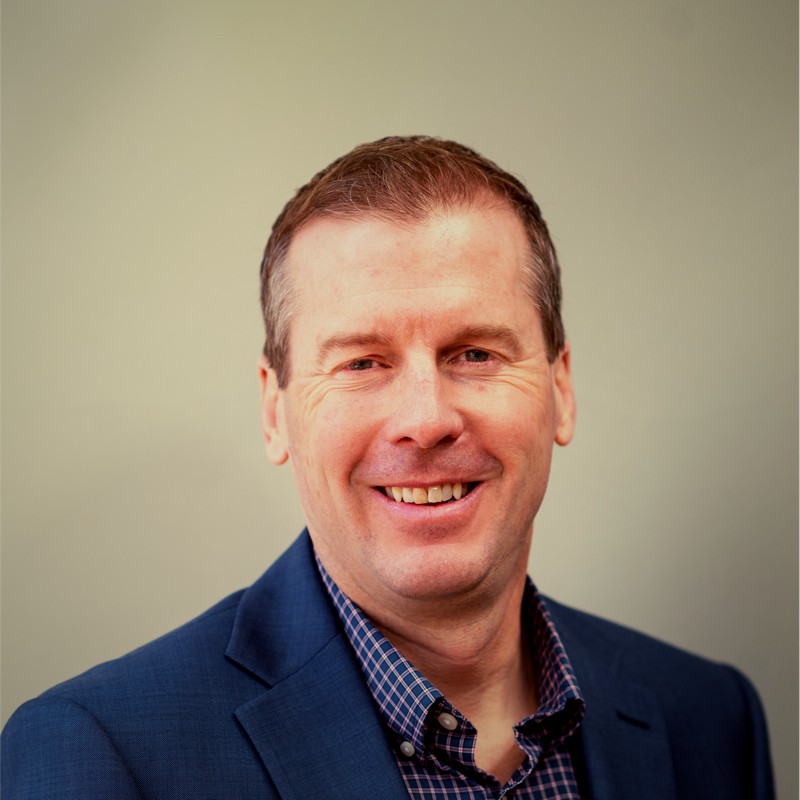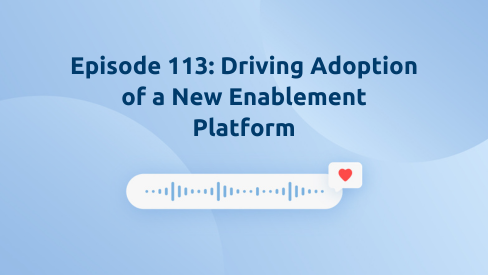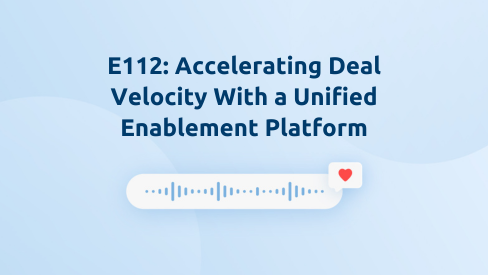According to a study conducted by Gartner, 77% of sellers struggle to complete tasks efficiently. So how can you improve the way that your sellers work?
Shawnna Sumaoang: Welcome to the Win Win Podcast. I’m your host, Shawnna Sumaoang. Join us as we dive into changing trends in the workplace and how to navigate them successfully.
Here to discuss this topic is Ben Taft, the vice president of global sales operations at Arm. Thank you for joining us, Ben. I’d love for you to tell us about yourself, your background, and your role.
Ben Taft: Hi, Shawnna. Thanks for having me today. As you mentioned, I run global sales ops at Arm, and I’ve been here a little under five years.
Prior to that, I had experience at both startups and Fortune 100 companies, running revenue ops, sales ops, and marketing ops. Everything in between from trying to get our first millions of dollars in revenue to billions of dollars in revenue. Looking forward to the conversation.
SS: As a sales operations leader, what are some of the key initiatives that you are focused on driving for the business this year?
BT: As I thought about your question there, I think two things really come to mind — and I’ll try not to be too marketing-speak or, lingo-speak on it — it does come down to business transformation as the first one. In an enablement, rev ops, and sales ops role, one of the elements is we have to find ways to bring in all of the other groups we work with. Whether it’s marketing, whether it’s the field teams, whether it is our product teams, engineering teams, or our solution experts.
We’ve got to bring them together to find, a way to get that information in people’s hands as quickly as possible so that they can make use of it. The other element of that is with so much information, how do you simplify that down so you can scale it out quickly? If we rely on the legacy way of doing things and the legacy approach, whether it’s processes or the ways of working that we used to do, that’s not going to get us there.
And if anything, we are trying to look at all of those legacy mindsets and say, how do we completely rethink this from end to end? Cause with so many people involved, that just elongates the overall process. So, it really comes down to how can we find better ways to transform with all of those different stakeholders.
And how can we simplify it so people actually feel like this is happening a lot faster than I’m used to, and so let’s do more of this.
SS: Those are some big initiatives. So from your perspective, Ben, what role does your enablement tech stack play in helping you land these initiatives?
BT: One of the ways I think about it is a phrase I’m using called time to education.
And this is where I’ve seen a massive improvement with some of our sales enablement, like Highspot. It gives us analytics that connects content owner’s right to deals in some cases, or right to the people that are at the front of this. If we can improve that time to education, that allows people to use that information with a lot more veracity and a lot more velocity.
It comes down to the legacy approach, obviously. I’ve got something, I’ve got to get it out to the field, or I’ve got something people can find valuable, and it will help them in their conversations with customers or whoever they’re engaging with. But, if it ends up taking us months and months to get that put out there to go through review cycles, or it gets put out in a way that’s static and dormant, and it doesn’t get all the amplification or it doesn’t come across in a rich and engaging fashion, it’s like you never put it out there to begin with.
If I can shorten that time to education, that becomes a huge factor. But, one of the more interesting elements of that whole thing is traditional groups that I would have to go to extract all that knowledge out and then put it back to a team and say, “Okay, take all this goodness and put it in some way that people will find engaging.” A tool like Highspot now allows for non-traditional content owners or experts to immediately put that out there. I find that some of those folks are finding that is incredible development opportunities. It’s not just PowerPoint that they have to go write and it’s not some boring brief they’ve got to write.
Now they’re creating these spots they’re creating a rich set of information out there. And they’re feeling like mini developers, in a sense. It’s such an easy way to do it that the time to education dramatically decreases and suddenly it’s out there very quickly. People are consuming it and they can see it being consumed with all the analytics. In a lot of ways, it allows me to scale beyond the traditional content owner process, and you’re creating a lot of new content owners, and they’re having a lot of fun with it.
SS: I love that. Now on the topic of scale, I know that you also believe in the philosophy that implementing enablement technology is key to accelerating revenue while improving operational scale. Can you tell us more about how enablement helps to drive those outcomes?
BT: The way I think of it is the abundance of information doesn’t necessarily guarantee the relevance or value of each piece of that information. A really well-thought-out enablement stack changes that, right? You now have an ability to really isolate down on what they need at that particular point in time.
Now that’s a bit of a cliche I know, and I said I wouldn’t do that, but it’s: what do I need right now at this point? Even though we all strove to do that, the legacy enablement stacks still didn’t really solve that problem. Somebody could search for something and imagine they’re in a library; they’re looking for that book and they see all sorts of things they can’t make use of.
We now have the ability to be much more refined on that. That goes back to my earlier statement about time to education. It’s now allowing people to get it out there in a much more refined way, a much more sophisticated way. And that gets you to outcomes at a much quicker rate. And it also goes back to allowing some of those non-traditional content owners to be much more invested in that process.
And when they’re much more invested and they see outcomes at a much quicker rate, their buy-in becomes, they’re like that worked completely different than my usual experience. How do I do more of that? And that changes the outcomes that we see.
SS: I absolutely love that. So Ben, for our audience out there how did you go about finding the right enablement tools to help you drive these outcomes, what were maybe some of the key factors that you were considering?
BT: Oh, probably nothing, groundbreaking in some of that regard. Obviously it starts with what the user experience looks like. I definitely have a philosophy, of the hub and spoke approach. I think that there are traditional platforms that act as an anchor across your business, and then you plug in sort of platforms or tools that are really purpose-built for what your field teams need at that particular time. And that starts with user experience meaning. Does that tool think the way my salespeople think in some regards? Is it set up in an intuitive fashion that is driven by people that, where they think this is how I would search or how I’d want to use this information, or this is how I’d want to present it back to my customers?
And if everything, the tool or the enablement or however tools we use takes that sort of approach on it. I find that my time to get people ramped up on it dramatically decreases, and the faster I get people ramped up on it, the better. So it starts with user experience. A really high-end user experience translates to a lower ramp-up time, and that lower ramp-up time then suddenly yields better analytics.
And so suddenly now you have all of these analytics about where you got it right, and maybe where you didn’t get it right, and you can quickly pivot in on the things that you didn’t get quite right. And go back to the drawing board. And then the last piece is I really want something that stands out on all my tools.
I look for something that maybe is going to be a little disruptive, a little progressive, or it’s going to look not like some of the tools we’ve traditionally had. And, because I want people to go, this is different, this is cool. And I want people to have that feeling like they’ve just unwrapped something cool under the the Christmas tree or whatever.
And if they get excited about it then that makes my job a lot easier.
SS: One thing I think that sellers are definitely getting excited about on that note a little Christmas in July, but digital rooms are really popular amongst sellers these days. They create opportunities for sellers to really foster deeper engagement with their buyers and their customers. Can you share how you see Digital Rooms changing the traditional go-to-market motion for your sellers?
BT: I’ll probably step back even in terms of just Digital Rooms in general. One aspect of enablement tools is your traditional audiences will always lap it up and adopt it. But as I look at the spectrum, you may have groups on your field teams or your marketing teams or whatever that sort of lag behind, either because of cultural norms, how they do business, different, maybe there’s language gaps, or maybe there’s just.
For whatever reason, there just tends to be gaps in how they adopt things. One thing I’ve seen with Digital Rooms is some of the traditional groups that maybe haven’t adopted as quickly have actually been some of the early adopters in some cases. And I think this has to do with the fact that their relationships with their customers tend to maybe have a different, it’s different than, every region has a slightly different engagement with their customer due to how they, cultural norms or regional norms or what have you.
I find that things like Digital Rooms actually allow groups to really get customized and tailored to be really bespoke in terms of how they set that up. And it goes back to something I mentioned earlier about non-traditional folks taking ownership inside of a tool, like a Highspot, and suddenly they’re building things and they’re doing things that I’m not even aware of.
I have not even laid out to them and they’re pushing the envelope on the tool faster than I am. That is really cool because now I’m getting all sorts of different ideas and innovations that maybe I hadn’t thought of in the past. It’s so easy and quick for them to do it, that it allows them to get very bespoke to what they need.
They’re still operating within the confines of what we’ve provided, and it allows them to, get even deeper into those engagements with their customers. I find that the biggest thing that I see of concepts like Digital Rooms, is it maybe allows some of the non-traditional user sets or non-traditional heavy users to suddenly expand their use cases.
SS: I love that, it’s like a force multiplier effect. So I love that’s what’s happening with Digital Rooms at Arm. I do want to go back to something that you had just said in your response prior to that, which was around all of the information and analytics. You’ve talked a lot about how important it is to have access to that, especially vis-a-vis your enablement platform. How do you utilize data to help drive sales execution?
BT: So there are two things in an approach. One is, you’ve got an enablement platform where all that information resides. But I also have deployed what I call the bar. The bar is business analytics and reporting. This is a separate sort of function, and so when you need information, you go to the bar. And you order up your drink in terms of what you want, so the bar is a group that is trying to take vast amounts of data and put it in very visual, very useful, and informative ways. There’s nothing groundbreaking about that. But when your enablement platform and your bar capabilities become almost the foundations for every informational piece that goes out to the field, or your field teams, or your marketing teams. When that becomes two anchor points, we’ve got something great we want you to learn, or we’ve got great information we want you to digest, here’s where you can find it.
And by the way, it’s a really rich experience, and you’ll get all this. And by the way, here’s where you can go see information in terms of how that information is being used and how you may apply it to all, the things you’ve got going on in your space. Marrying up enablement stack plus rich analytics that has now taken root, when those are the anchor points of all of your education efforts then the rest is just, it becomes a well-oiled machine.
And people know what to expect. I know where to find it, I know what I’m going to get, and I know I’m going to get what I need. And I’ve got a resource to then go track how it’s working for me.
SS: Absolutely. And so to that point, how do you see enablement tools helping to improve efficiency and enable sellers to become more effective?
BT: We’ve touched on some of those things. I think that enablement tools changed how users interact with that content. I used to joke that 80% of it was trying to figure out where was that specific PowerPoint. And I know that’s early 2000s in a way, I’m probably dating myself here.
But you forget at the last miles, many times it’s people trying to stitch together some information. And I think a really well thought out enablement stack and some of the tools that surround that in the other parts of the sales go-to-market motion.
They’ve really allowed people to get back to the work of putting together value for their customers as opposed to searching for stuff and trying to understand do they have all the right pieces and where did that go? And it used to be there, but it’s no longer there. And so enablement stacks, some of the other go-to-market motion players that really do this well.
It’s allowed people to get back to—especially our sales groups—doing what they want; putting together really a rich set of value propositions that they can go back to their customers with. And it’s meaningful they do it with pace. It’s timely for what their customers are looking to see.
And then it allows all of the analytics to understand how is it being consumed and did I get the right thing. And did I give them what they needed at the right time? And, by the way, if it’s a Digital Room, I did it in a way that can be very intimate with the partner so that it feels very personable to them.
I think that’s changed the way people think about it. And I really think it’s become table stakes in terms of how sellers expect to have that information available and expect to be able to act with pace, that they’re able to quickly put together what their customers want in a very personable fashion.
SS: That’s a really interesting segue to my next question, which is how do you see innovations like AI helping teams achieve even more efficiency? And how are you beginning to leverage AI today?
BT: So like many organizations, we’re studying AI at this point, trying to understand where the right use cases are.
Obviously [AI] has incredible promise. It’s going to be transformational, I absolutely believe that. But, I also think that many times RevOps groups and sales ops groups, really serve a unique purpose in an organization of being one of the true great knowledge workers inside of an organization.
They’re stitching together many times marketing, products, engineering, finance, all of the executive needs, all these different things. So, AI comes into play in terms of where we see people needing to be more effective in that. We’re still early in our journey exploring that. I do think AI’s a tremendous capability to drive some different kinds of insights and help people. become much more effective in their particular execution of something. For example, I sat on a panel not too long ago and there was an individual [who] talked about some of his CSMs. This was not at my current organization, [but] he talked in terms of using AI where they are deploying where every morning a CSM might wake up and see a 15-point action plan that they were expected to execute.
AI had generated and drafted that 15-point plan down to the emails, down to the invites, and down to the CRM updates. But where the CSM got better, is they were then supposed to review that action plan and make tweaks to it. So they’re not spending eight to ten hours developing all of that content and action plan.
They spent 30-minutes reviewing it and making it really tailored to their customers. Now making that CSM much more effective in their job. They’re able to apply a lot more intelligence to it, a lot more personal touches to it, because the hard work is done and now they can say, “You know what, my customer X doesn’t like to receive emails on Monday because it’s just a bad day for them in terms of what they get. I’m going to re-tailor this thing for a Tuesday type of thing.” That’s tactical, but it’s a really unique example of what it does. We’re [on] our journey to find out how AI can do similar things.
SS: Last question—in terms of your journey looking ahead, Ben, what are your key priorities for the future of sales operations at your organization?
BT: Like I’ve done and looked at prior roles. I look at, RevOps, sales ops, and our capabilities on a scale of one to five. One might be, it’s a process or a capability that is in its infancy or still very manual or reactive, to a five, which is it’s highly predictive, it’s sophisticated.
Maybe it’s that process now providing insights in advance of it happening and allowing the organization to pivot and be prepared for it. It’s delivering a different level of value to the business. One of the things that I look at is we step into that AI journey, and as we step into the next, changes in our industry, is all these tools provide new capabilities.
One thing top of mind is to look at all of our existing processes and capabilities on that scale and say, “Okay, I need to reset that scale and understand: where on our sales ops capabilities do we need to go from one to five? Or, if we’re at a three, where do we need to go from three to five? So that’s where I’m going to be spending some time and focus, is how do I mature those next set of capabilities, in light of how AI will make some of those transitions possible.
That maybe where it was going to take us a long time to get even from one to three, perhaps I can leapfrog that and now go from one to four, or from two to five. The old scale is broken and now my new thing is to figure out: what does that new scale look like, and how do I go measure it against what we’re currently doing.
SS: I absolutely love that and I think you are looking around all the right corners, Ben. Thank you so much for joining us today. I really appreciated you sharing your expertise and insights here.
BT: Shawnna, for having me. It’s been a pleasure.
SS: To our audience, thank you for listening to this episode of the Win Win Podcast. Be sure to tune in next time for more insights on how you can maximize enablement success with Highspot.



